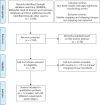Surgical performance when inserting non-locking screws: a systematic review
- PMID: 32071771
- PMCID: PMC7017595
- DOI: 10.1302/2058-5241.5.180066
Surgical performance when inserting non-locking screws: a systematic review
Abstract
Billions of screws are inserted by surgeons each year, making them the most commonly inserted implant. When using non-locking screws, insertion technique is decided by the surgeon, including how much to tighten each screw. The aims of this study were to assess, through a systematic review, the screw tightness and rate of material stripping produced by surgeons and the effect of different variables related to screw insertion.Twelve studies were included, with 260 surgeons inserting a total of 2793 screws; an average of 11 screws each, although only 1510 screws have been inserted by 145 surgeons where tightness was measured - average tightness was 78±10% for cortical (n = 1079) and 80±6% for cancellous screw insertions (n = 431).An average of 26% of all inserted screws irreparably damaged and stripped screw holes, reducing the construct pullout strength. Furthermore, awareness of bone stripping is very poor, meaning that screws must be considerably overtightened before a surgeon will typically detect it.Variation between individual surgeons' ability to optimally insert screws was seen, with some surgeons stripping more than 90% of samples and others hardly any. Contradictory findings were seen for the relationship between the tightness achieved and bone density.The optimum tightness for screws remains unknown, thus subjectively chosen screw tightness, which varies greatly, remains without an established target to generate the best possible construct for any given situation. Work is needed to establish these targets, and to develop methods to accurately and repeatably achieve them. Cite this article: EFORT Open Rev 2020;5:26-36. DOI: 10.1302/2058-5241.5.180066.
Keywords: bone screws; fracture fixation; internal fixation; screw insertion; screw tightness; stripping torque; surgical technique.
© 2020 The author(s).
Conflict of interest statement
ICMJE Conflict of interest statement: JWAF reports a Research Fellowship with the Royal College of Surgeons of England for the submitted work. LW reports she is the Chair of the ‘Junges Forum O und U’ - the political board of young trauma and orthopaedic surgeons in Germany; research funding from Forschungsförderungsfond der Paracelsus Medizinischen Privatuniversität, PMU Rise Projekt, Kategori: Newcomerprojekt (research funding of the Paracelsus Medical Private University, Rise project in the category ‘newcomer project’), all outside the submitted work. RGR reports support for travel to meetings for the study or other purposes from AO Research Institute Davos for the submitted work. HSG reports a grant covering first author from the Royal College of Surgeons for the submitted work. The author reports consultancy to Zimmer Biomet and an educational grant from Smith & Nephew; and membership of the BJJ Editorial Board, with expenses for attending meetings reimbursed outside the submitted work. EP reports they are a co-investigator in the fellowship application of the corresponding author from David Telling Charitable Trust and Royal College of Surgeons for the submitted work. MRW reports grant salary costs from the National Institute for Health Research Bristol Biomedical Research Centre, University Hospitals Bristol NHS Foundation Trust and University of Bristol, National Joint Registry Lot 2 contract, Stryker (Triathlon); royalties for being editor of an orthopaedic textbook from Taylor & Francis; undertaking teaching on basic sciences for orthopaedic trainees preparing for the FRCS for which the author’s institution receives market-rate payment from Heraeus; undertaking teaching on total hip replacement for orthopaedic consultants and trainees for which the author’s institution receives market rate payment from DePuy, all outside the submitted work. The other authors declare no conflict of interest relevant to this work.
Figures



References
-
- Egol KAMD, Kubiak ENMD, Fulkerson E, Kummer FJP, Koval KJMD. Biomechanics of locked plates and screws. J Orthop Trauma 2004;18:488–493. - PubMed
-
- Collinge C, Hartigan B, Lautenschlager EP. Effects of surgical errors on small fragment screw fixation. J Orthop Trauma 2006;20:410–413. - PubMed
-
- Wall SJ, Soin SP, Knight TA, Mears SC, Belkoff SM. Mechanical evaluation of a 4-mm cancellous ‘rescue’ screw in osteoporotic cortical bone: a cadaveric study. J Orthop Trauma 2010;24:379–382. - PubMed
-
- Moher D, Liberati A, Tetzlaff J, Altman DG; PRISMA Group. Preferred reporting items for systematic reviews and meta-analyses: the PRISMA statement. Ann Intern Med 2009;151:264–269, W64. - PubMed
Publication types
LinkOut - more resources
Full Text Sources

